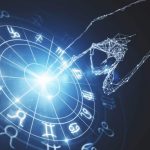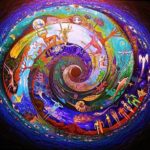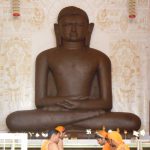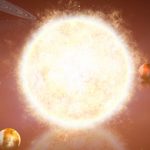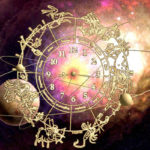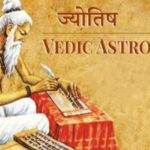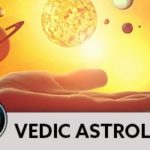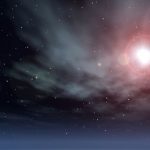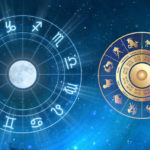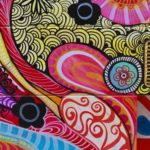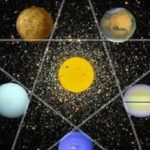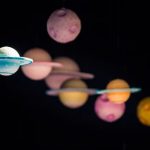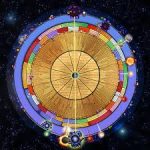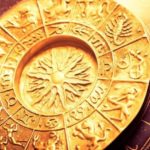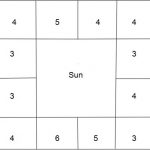Planets/ Grahas in Vedic Astrology: Navagraha
- There are seven planets (grahas) in Vedic astrology
- They are Sun, Moon, Mars, Mercury, Jupiter, Venus and Saturn.
- Two more chaayaa grahas (shadow planets) are listed: Rahu and Ketu.
- Rahu and Ketu are axis and mathematical points. They are also called the north and south nodes or the head and tail of dragon and are based on the points at which the orbit of Moon around earth cuts the orbit of earth around Sun.
- A total of nine planets: Navagrahas.
Rasis represent situations that develop in one’s life and influences that enter one’s life. Planets in a chart represent human beings that play a role in one’s life.
The assumption is that the whole zodiac represents Lord Vishnu and rasis represent his limbs and planets represent Vishnu’s incarnations which are manifestations of the Jeevamsa (Living essence) and parammatmamsa (Supreme).Matsya avatara (fish) came from Ketu.
- Koorma avatara (tortoise) came from Saturn.
- Varaaha avatara (boar) came from Rahu.
- Narasimha avatara (half man and lion) came from Mars.
- Vaamana avatara (enlightened dwarf) came from Jupiter.
- Parasu Rama avatara came from Venus.
- Rama came from Sun.
- Krishna came from Moon.
- Buddha came from Mercury.
Planetary Friendship:
| Planet | Friends | Neutral | Enemies |
| Sun | Moon, Mars, Jupiter | Mercury | Venus, Saturn |
| Moon | Sun, Mercury | Mars, Jupiter, Venus, Saturn | |
| Mars | Sun, Moon, Jupiter | Venus, Saturn | Mercury |
| Mercury | Sun, Venus | Mars, Jupiter, Saturn | Moon |
| Jupiter | Sun, Moon, Mars | Saturn | Mercury, Venus |
| Venus | Mercury, Saturn | Mars, Jupiter | Sun, Moon |
| Saturn | Mercury, Venus | Jupiter | Sun, Moon, Mars |
- Lord of Moolatrikona and 2nd, 4th, 5th, 8th, 9th, 12th from it are friends.
- Rest are enemies.
- If a planet is conflicting ( friend and enemy) then it is neutral
Planetary characteristics and comparison:
| Planets | |||||||||
| Sun | Moon | Mars | Jupiter | Saturn | Rahu | Ketu | Mercury | Venus | |
| Benefics | Waxing | with Benefic | |||||||
| Neutral | |||||||||
| Malefics | Waning | with Malefic | |||||||
| Representation | Soul | Mind | Strength | Knowledge | Hard work | Deceit | Spirituality | Speech | Potency |
| Kingdom | King | King | Commander | Priest | Worker | Soldier | Soldier | Prince | Minister |
| Dieties | Agni( Fire) | Varuna ( Rain) | Subramanya | Indra | Brahma | Maha Vishnu | Devi | ||
| Sex | Male | Female | Male | Male | Female | Female | Neutral | Female | Female |
| Elements | Agni Tattwa | Jala Tattwa | Agni Tattwa | Akash Tattwa | Vayu Tattwa | Bhoo Tattwa | Jala Tattwa | ||
| Caste | Kshatriya | Vaishya | Kshatriya | Brahmana | Shudra | Vaishya | Brahmana | ||
| Guna | Sattvik | Sattvik | Tamasik | Sattvik | Tamasik | Rajasik | Rajasik | ||
| Abode | Temple | Watery Place | Battle area | Treasure area | Filthy area | Play Area | Bedroom | ||
| Body | Bones | Blood | Marrow | Fat | Muscles | Skin | Reproduction | ||
| Time | Half Year | Minute | Week | Month | Year | Season | Fortnight | ||
| Taste | Pungent | Saline | Bitter | Sweet | Astringent | Mixed | Sour | ||
| Direction | Southern | Northern | Southern | Eastern | Western | Eastern | Northern | ||
| D/N Strength | Day | Night | Night | Day | Night | Anytime | Day | ||
| Seasons | Varsha | Greeshma | Seetha | Shishira | Hemantha | Vasantha | |||
| Rainy | Summer | Winter | Fall | Dew | Spring | ||||
| Articles | Vegetables | Minerals | Metals | Living Beings | Metals | Living Beings | Vegetables | ||
Planetary Dignities
- Each planet has a sign where it is exalted, a sign where it is debilitated and a sign that is called its Moolatrikona and one or two rasis that are owned by it.
- A planet is said to be strong in its own rasi or exaltation rasi or Moolatrikona.
Dignities of Planets
| Planet | Own rasis | Exaltation rasi (exaltation point) | Debilitation rasi (debilitation point) | Moolatrikona |
| Sun | Le | Ar (10º) | Li (10º) | Le |
| Moon | Cn | Ta (3º) | Sc (3º) | Ta |
| Mars | Ar & Sc | Cp (28º) | Cn (28º) | Ar |
| Mercury | Ge & Vi | Vi (15º) | Pi (15º) | Vi |
| Jupiter | Sg & Pi | Cn (5º) | Cp (5º) | Sg |
| Venus | Ta & Li | Pi (27º) | Vi (27º) | Li |
| Saturn | Cp & Aq | Li (20º) | Ar (20º) | Aq |
| Rahu | Aq | Ge | Sg | Vi |
| Ketu | Sc | Sg | Ge | Pi |
Difference between own Rasi, Exaltation Rasi and Moolatrikona.
- Own rasi of a planet is like one’s home and is most natural and comfortable at home.
- Moolatrikona of a planet is like a work place and is powerful, focused and duty-minded at office.
- Exaltation sign of a planet is like a fun place and is excited.
- For example: Jupiter is at home in Pisces and is dharmic there, at work in Sagittarius and is a priest there and in cancer is imaginative/ learning and debilitated in Capricorn.
- Mercury as another example – He is an intellectual planet and significator of communications. “Intelligent communication” is the most comfortable activity for him in his home Gemini. Virgo is his Moolatrikona where he is interested in Debates etc.
Each Graha/ Planet is supposed to contain a specific energy quality representing the Pancha Tattwa s and get connected in a specific way to the individual energies and evolves over the life of the Individual.
Humans are also capable to tune themselves to the chosen energy of specific planet by connecting with that planet or its presiding deity. The effects of worship of specific deities are manifested accordingly to their relative energies of the person and depending on the Bhavas occupied by the respective Grahas. The cosmic energy we always receive contains different energies coming from different celestial bodies and when we repeatedly utter a Mantra we are tuning to a particular frequency and connect with the cosmic energy.
Navagraha from British Museum.
From left: Surya, Chandra, Mangala, Budha, Brihaspati, Shukra,Shani, Rahu, Ketu
Surya in his chariot driven by seven horses.
Surya is the chief of solar system, one of the Adityas and son of Kasyapa. Represented in a chariot pulled by seven horses (representing seven chakras). Very visible form of God, the number associated in one and children include Shani (Saturn), Yama (God of Death) and Karna.
Invoking Gayatri Mantra or Aditya Hrudaya Mantra (Adityahridayam) are known to please the Sun God.
Chandra
Chandra represented on his chariot of antelope.
Chandra is a lunar Vedic deity and is described as young, beautiful, fair, two-armed and having in his hands a club and a lotus. He rides his chariot across the sky every night and pulled by ten white horses or an antelope. He is connected with dew, and as such, is one of the gods of fertility. He is also called Nishadipati (Night Lord) and represents Mother.
Mangala is considered to be the god of war, action, confidence etc and son of Prithvi or Bhoomi (Earth goddess) He is represented in red or flame Colour, four-armed, carrying a trident, club, lotus and a spear. His Vahana (mount) is a ram.
Budha with Ila
Main article: Budha
Budha is the god of merchandise and protector of merchants and represents Communication. He is represented as being mild, eloquent and of greenish Colour and holding a scimitar, club, shield and riding a winged lion
Brihaspati represents knowledge and teaching. He is known as “Guru” and is usually depicted with an elephant or chariot drawn by eight horses as his vehicle. He is also depicted in a lotus flower and is described of yellow or golden colour and holding a stick, a lotus and his beads.
Shukra sculpture in British Museum.
Shukra represents wealth, reproduction and pleasure and is of white complexion and middle-aged. He is described variously mounted, on a camel or a horse or a crocodile. He holds a stick, beads and a lotus and sometimes a bow and arrow.
Shani on his mount crow.
Shani represents learning the hard way, Career and Longevity. The origin of word Shani comes from the following: Shanaye Kramati i.e. the one who moves slowly. Shani is son of Surya and Chhaya. It is said that when he opened his eyes as a baby for the very first time, the sun went into an eclipse, which clearly denotes the impact of Shani on mankind.
He is depicted dark in colour, clothed in black, holding a sword, arrows and two daggers and variously mounted on a black crow or a raven.
Rahu is God of the Ascending / North lunar node. Rahu is the head of the demonic snake that swallows the sun or the moon causing eclipses. He is depicted in art as a dragon with no body riding a chariot drawn by eight black horses. He is a Tamas Asura who does his best to plunge any area of one’s life he controls into chaos. The Rahu kala is considered inauspicious.
According to the Samudra manthan, the asura Rahu drank some of the divine nectar. But before the nectar could pass his throat, Mohini (the female avatar of Vishnu) cut off his head. The head, however, remained immortal and is called Rahu, while the rest of the body became Ketu. It is believed that this immortal head occasionally swallows the sun or the moon, causing eclipses. Then, the sun or moon passes through the opening at the neck, ending the eclipse.
Ketu
Ketu is considered as Tail of the Demon Snake. It is believed to have a tremendous impact on human lives and also the whole creation. Ketu helps someone achieve the zenith of fame and represents and spiritual and supernatural influences
Positioning of Navagrahas
Navagraha are typically placed in a single square with:
- Sun (Surya) in the center and the other deities surrounding Surya.
- Planets are not positioned to face each other.
- Usually placed in the north-east side of the sanctum sanctorum.
There are 2 kinds of installation of the planets – Agama Prathishta and Vaidika Prathishta.
In Agama Prathishta:
Surya occupies the central place, Chandra on Surya’s east, Budha on his south, Brihaspati on his west, Shukra on his north, Mangala on his south-east, Shani on his south-west, Rahu on north-west and Ketu in the north-east.
The traditional arrangement of the Navagraha
In Vaidika Pradishta:
Surya is still in the center, but Shukra is in the east, Mangala in the south, Shani in the west, Brihaspati in the north, Chandra in the south-east, Rahu in the south-west, Ketu in the north-west and Budha in the north-east.
The planets represent the following:
Sun: Atma (soul), self, self-realization, influence, prestige, power, valor, health, eye, general well-being, heat, splendor, father, king, royalty, royal favor.
Moon: The heart, understanding, inclinations, emotions, sleep, happiness, good name and fame, facial luster, mother, royal favor, affluence, travel, water reservoirs.
Mars: Stamina, courage, desire, anger, scandal, diseases, enemies, opposition, controversies, weapons, commander of an army, land, immovable properties, younger brother, relations such as cousins.
Mercury: Intelligence, discrimination, speech, expression, education, learning, mathematics, logic, astrology, medical knowledge and profession, writing, publishing, acting as a middleman in trade or politics (diplomacy), dancing, mixture of things, leafy trees, testing of precious stones, charms (amulets), maternal uncles, friends.
Jupiter: Wisdom, learning, corpulence, acts of religious merit, devotion to God, ancestors and superior beings, holy places, scriptures, proficiency in learning, philosophy, giving alms or donations, benevolence, wealth, respect, sons, religion, preceptors, fruit, fruit trees.
Venus: Spouse, marriage, sexual matters, pleasures of the senses, singing, poetry, scents, ornaments, jewelry, all articles of luxury, cooperation with and from others, flowers, flowering trees, beauty, buying and selling, cows, watery places.
Saturn: Longevity, life, death, adversity, calamities, disrespect, diseases, poverty, livelihood, servility, unrighteous conduct, learning of sciences and foreign languages, agricultural pursuits, minerals, oils, things buried deep in the ground and coming out there from, servants (male and female), service, theft, cruel deeds, malice, lameness, very old, persons.
Rahu(North Node of the Moon): Paternal grandfather, fallacious argument, harsh speech, gambling, movement, travelling, outcastes, foreigners, snakes, snakebite, theft, wickedness, widow(er), intrigue with a widow(er), skin diseases, itches, eczema, acute or sharp pain in the body, hiccoughs, swelling in the body.
Ketu (South Node of the Moon): Maternal grandfather, consumption, pain, fever, wound, witchcraft, causing trouble to enemies, horned animals, dog, cock, birds with spots or of variegated colors, philosophy, salvation.
–




